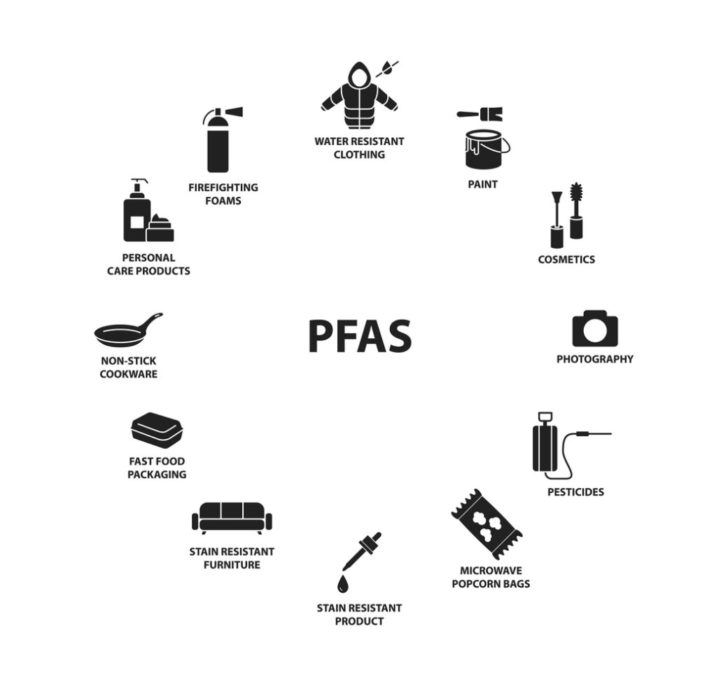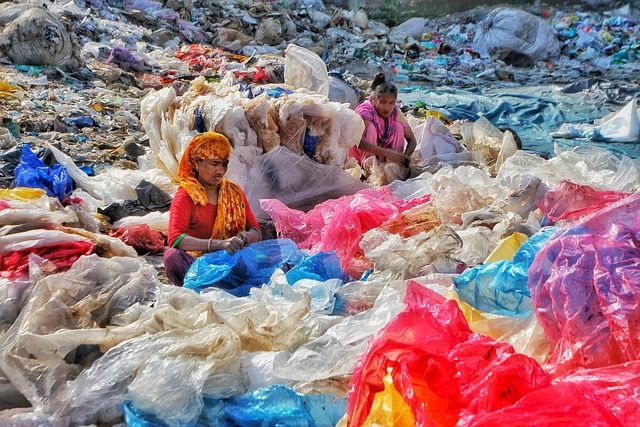Unveiling the impact of PFAS chemicals on our environment is crucial for understanding their far-reaching consequences. These “forever chemicals” have infiltrated our everyday lives, contaminating drinking water, food, and consumer products. This blog post will delve into the history, uses, and health risks of PFAS, as well as the policy efforts being made to combat their effects. Join us as we explore this complex issue and illuminate the extent to which PFAS contamination affects our world.
Table of Contents
Short Summary
PFAS contamination is a hazardous and pervasive issue due to its long-term presence in the environment and our bodies.
Sources of PFAS include industrial dumping, landfill seepage, consumer products like nonstick cookware & stain-resistant carpeting.
Policy efforts are aiming to reduce PFAS exposure. Action is needed for effective regulation & protection from its effects.
Understanding PFAS Chemicals

Polyfluoroalkyl substances (PFAS) are human-made chemicals that have been used since the 1950s in a variety of consumer products and industrial processes, thanks to their water, heat, and grease-resistant properties. Unfortunately, these synthetic chemicals are also persistent in the environment and our bodies, leading to a range of health risks, even at very low levels of exposure. As their presence in our lives becomes more apparent, the need for understanding and addressing PFAS contamination is vital.
The primary sources of PFAS exposure are through consuming PFAS-contaminated water or food, using products containing PFAS, and inhaling air with PFAS particles. Despite their hazardous nature, avoiding these chemicals has proven challenging due to their ubiquity in consumer goods and the lack of regulation or testing by the U.S. The Environmental Protection Agency (EPA) is an established organization committed to protecting our environment. It takes important measures to ensure that regional environments are safe and healthy for all.
The History of PFAS Production
PFAS chemicals have been manufactured since the 1940s, with companies like 3M being one of the primary producers. Initially, PFAS were employed in nonstick and waterproof coatings, setting the stage for their widespread use in various industries. However, it wasn’t long before studies conducted by 3M and DuPont in the 1950s and 1960s revealed that PFAS could accumulate in our blood and potentially present health risks.
Despite these early findings, it took decades for the potential dangers of PFAS to be acknowledged and addressed. Over time, certain PFAS have been phased out from commercial use, but they remain present in the environment due to their persistence. Today, we can still find PFAS in firefighting foams and everyday products, a testament to their widespread and lasting impact.
Common Uses of PFAS
PFAS are utilized in a broad array of products and applications. Apparel, furniture, adhesives, food packaging and heat-resistant non-stick cooking surfaces are some of the common uses of insulation of electrical wire. It is also used for other heat resistant applications. They are also employed in cleaning products, paints, and fire-fighting foams, further contributing to their widespread presence in our lives.
The FDA has authorized certain PFAS for limited use in cookware, food packaging, and food processing equipment. However, this authorization doesn’t negate the potential health risks associated with PFAS exposure. As our understanding of their effects on human health grows, the need for regulation and alternatives becomes increasingly important.
Sources of PFAS Contamination

PFAS contamination can originate from numerous sources, including industrial dumping and landfill seepage, as well as consumer products like nonstick cookware and stain-resistant carpeting. Currently, there are no restrictions on industrial PFAS discharges under the federal Clean Water Act or the Clean Air Act, making it difficult to control and monitor PFAS pollution.
Understanding the origins of PFAS contamination is crucial for addressing its impact on our environment and health. In this section, we will examine the various sources of PFAS contamination, including industrial dumping and landfill seepage, as well as consumer products and disposal.
Industrial Dumping and Landfill Seepage
Contamination in water systems from PFAS can result from various sources. This includes industrial dumping into rivers, lakes and streams, as well as the seeping of PFAS into groundwater from the landfill or from incinerated products and wastes containing PFAS. Water systems in 50 states are contaminated with PFAS, affecting an estimated 200 million Americans.
However, the EPA only tests for a small number of PFAS chemicals, rendering their approach insufficient. This lack of comprehensive testing means that the true extent of PFAS contamination in our water systems remains obscured, leaving communities vulnerable to the potential health risks associated with PFAS exposure.
Consumer Products and Disposal
In addition to industrial dumping and landfill seepage, PFAS contamination can also originate from consumer products. Items such as nonstick cookware, pizza boxes, stain repellants, cleaners, and building materials can contain PFAS. Furthermore, a 2018 FDA study found PFAS in food through packaging and contamination from soil, water, and air. PFAS have also been detected in fish and shellfish, further emphasizing their widespread presence in our environment.
Understanding the role of consumer products and disposal in PFAS contamination is crucial for developing effective strategies to mitigate their impact on our environment and health. With this knowledge, we can make more informed choices about the products we use and advocate for stronger regulations to protect our communities from the dangers of PFAS exposure.
Assessing the Health Risks of PFAS Exposure
Research has suggested that exposure to very small doses of PFAS may be associated with cancer, reproductive and immune system harm, and other diseases. Despite the potential health risks, our understanding of the human health effects of exposure to PFAS remains inconclusive, and further research is required.
In this section, we will explore the health risks associated with PFAS exposure, specifically focusing on the differences between long-chain and short-chain PFAS, as well as their effects on vulnerable populations.
Long-Chain vs. Short-Chain PFAS
Long-chain PFAS possess a greater number of carbon-fluorine bonds than short-chain PFAS, which can affect their respective health risks. While the chemical industry maintains that short-chain PFAS chemicals are safer, there is still much to learn about their potential health effects.
PFAS chemicals have been linked to a wide range of health risks, many of which were known by the chemical industry decades ago but not disclosed to the public. Today, PFAS chemicals can be found in clothes, home goods, and even our food, putting families, especially children, at risk.
It is crucial that we continue to study the health effects of these chemicals to better understand their impact on our well-being.
For more information please visit Short or Long? PFAS Chain Length Impacts on Regulation and Treatment for Landfill Leachate
Vulnerable Populations
Certain populations are more susceptible to the effects of PFAS exposure. Workers involved in the production or handling of PFAS and PFAS-containing materials are more prone to exposure than the general public. Additionally, infants born to mothers who were exposed to PFAS can be exposed before birth, while breastfeeding, or while drinking formula mixed with PFAS-contaminated water. People with weakened immune systems may also be more susceptible to PFAS exposure.
Scientists are continually studying the effects of PFAS on humans and animals in an effort to better understand the full range of health risks associated with exposure. By identifying vulnerable populations and understanding their unique risks, we can work towards developing effective strategies to protect them from the dangers of PFAS exposure.
PFAS in Drinking Water and Food
PFAS chemicals can be found in our drinking water and food, posing a significant risk to our health. Contaminated drinking water systems serve 19 million people in 49 states, highlighting the urgent need for more comprehensive testing and regulation to address this issue.
In addition to drinking water, PFAS have also been found in food packaging and agriculture. In this section, we will explore the presence of PFAS in drinking water and food, as well as the potential health risks associated with their consumption.
Contaminated Drinking Water Systems
Michigan is the most affected state by PFAS contamination. However, testing has not been as extensive for this chemical in many other states. Unreleased federal data indicates that up to 110 million Americans may be drinking PFAS-contaminated water. This calls for more extensive testing and stricter regulation of this hazardous substance.
The EPA’s current testing methods for PFAS chemicals in drinking water are insufficient, as they do not test for a vast majority of them. This lack of comprehensive testing leaves communities vulnerable to the potential health risks associated with PFAS exposure and underscores the need for more robust and effective regulation.
PFAS in Food Packaging and Agriculture
PFAS chemicals are found in household items, including cosmetics, dental floss, and home goods, putting families, especially children, at risk. Unfortunately, manufacturers are not required to inform consumers about the presence of PFAS in their products, making it difficult for individuals to make informed decisions about the items they purchase and use.
By identifying PFAS-containing products and seeking out alternatives, we can take steps to limit our contact with these harmful chemicals. However, more comprehensive actions are needed to clean up and ban these chemicals for good, including enhanced surveillance of PFAS levels in drinking water, more stringent enforcement of existing regulations, and the development of effective alternatives.
PFAS in Household Items
Identifying PFAS-containing products and finding alternatives to them is essential for mitigating their impact on our health and environment. PFAS can be found in a variety of household items, such as non-stick cookware, stain-resistant fabrics, carpets, furniture upholstery, personal care products, and packaging materials.
In this section, we will explore how to identify PFAS-containing products and discuss potential alternatives to help limit exposure and protect our health and the environment.
Identifying PFAS-Containing Products
To identify PFAS-containing products, one should consult the brand’s website to ensure the elimination of PFAS from their products, look for labeling such as “PFOA-free” or “PFAS-free,” and avoid personal-care products made with TeflonTM or containing ingredients that include the words “fluoro” or ”perfluoro”. However, home goods manufacturers are not obligated to inform consumers of the presence of PFAS in their products, making it challenging to identify and avoid these items.
Manufacturers have begun using shorter-chain PFAS in response to growing concerns about their health effects. However, these “regrettable substitutions” can still pose similar health problems as their longer-chain counterparts, such as GenX and PFBS. Advocacy groups, like the NRDC, support regulating PFAS as a class to address the risks associated with both long-chain and short-chain PFAS.
Alternatives to PFAS-Containing Items
While complete avoidance of PFAS may be difficult, taking simple actions can help limit contact with these harmful chemicals. Some alternatives to PFAS-containing items include non-PFAS-based fluoro-surfactants, silicone-based surfactants, hydrocarbon-based surfactants, fluorine-free fire fighting foams, and other developing fire fighting foam technologies that avoid the use of fluorine.
Additionally, wax or clay-coated materials, polylactic acid (PLA), and other biodegradable polymers may be viable options as substitutes for PFAS-containing items. By seeking out and using these alternatives, individuals can take steps to limit their exposure to PFAS and protect their health and the environment from the effects of these persistent chemicals.
Policy and Regulation Efforts Against PFAS
Policy and regulation efforts against PFAS have seen victories in curbing the use of these harmful chemicals, including phaseouts and bans. However, more comprehensive actions are needed to clean up and ban these chemicals for good.
In this section, we will examine the current policy and regulation efforts in place to address PFAS contamination and explore future directions for more comprehensive action.
State and Federal Regulations
Several state regulations on PFAS exist, and the EPA is proposing the first-ever national drinking water standard to limit six PFAS chemicals. However, no federal mandate is in place to regulate PFAS in drinking water, meaning that not all public water systems are obligated to test for these chemicals or take steps to filter them out of their supplies before it reaches consumers.
Congress has enacted an annual defense spending bill that addresses the issue of PFAS discharges into drinking water sources. It also includes provisions to expedite the military’s cessation of using PFAS in food packaging as well as firefighting foam. While these measures are a step in the right direction, more comprehensive action is needed to address PFAS contamination effectively.
Future Policy Directions
Maine has passed legislation prohibiting sales of items containing PFAS, apart from unavoidable use, which will become effective in 2030. Additionally, the Biden administration has initiated the development of a national primary drinking water regulation for PFAS.
These policy efforts are promising, but more comprehensive actions are needed to address the full scope of PFAS contamination. By advocating for stricter regulations, enhanced surveillance of PFAS levels in drinking water, and the development of effective alternatives, we can work towards a future free from the harmful effects of these “forever chemicals.”
Summary
Throughout this blog post, we have unveiled the impact of PFAS chemicals on our environment and health. From their widespread use in consumer products and industrial processes to their presence in our drinking water and food supplies, these persistent chemicals pose a significant threat to public health. While progress has been made in reducing PFAS use and implementing policy measures to address contamination, more comprehensive action is needed to protect our communities and the environment. Only through continued research, advocacy, and innovation can we hope to overcome the challenges posed by these “forever chemicals” and build a safer, healthier future for all.
Frequently Asked Questions
What products contain PFAS chemicals?
Many products including nonstick cookware, food packaging, and stain-resistant fabric contain PFAS chemicals. Unfortunately, these toxic substances are increasingly present in our everyday lives.
What do PFAS chemicals do to the body?
PFAS chemicals can cause a variety of health effects, ranging from cancer, to liver damage and fertility issues. Recent studies have also linked PFAS to an increased risk of asthma and thyroid disease.
Additionally, these toxins remain in the environment indefinitely, migrating into air, dust, food, soil, and water.
What is PFAS found?
PFAS are found in everyday products, water, air, fish, and soil around the world. Research has demonstrated that some of these chemicals can be linked to serious health problems.
Thus, it is essential to be aware of the potential risks associated with exposure to these compounds.
Is Teflon considered PFAS?
Yes, Teflon is considered PFAS (per- and polyfluoroalkyl substances), as it belongs to a subgroup of PFAS called fluorinated polymers, and PTFE (polytetrafluoroethylene), the compound that makes up Teflon, is by far the most popular one in the group.
PTFE is a synthetic material that is resistant to heat, chemicals, and corrosion, making it an ideal choice for a variety of applications. It is also non-stick, which makes it a popular choice for cookware. Additionally, it is used in a variety of industrial applications, such as in the production of electrical insulation, gaskets, and seals.









